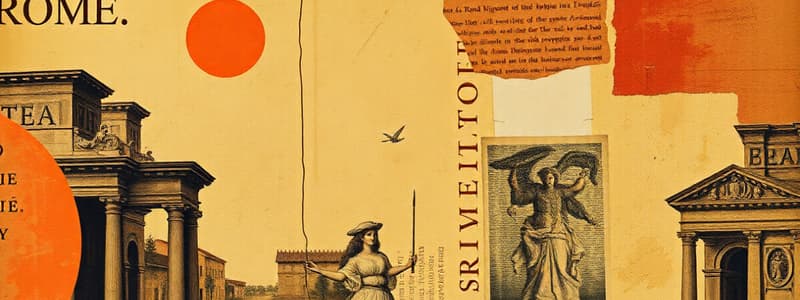Podcast
Questions and Answers
The Latin word 'liber,' from which the English word for 'book' is derived, originally referred to what physical object?
The Latin word 'liber,' from which the English word for 'book' is derived, originally referred to what physical object?
- A codex made of parchment.
- A papyrus roll. (correct)
- A collection of wax tablets bound together.
- A single clay tablet inscribed with text.
A Roman wishes to correct an error on a papyrus scroll. Which of the following tools would they be most likely to use?
A Roman wishes to correct an error on a papyrus scroll. Which of the following tools would they be most likely to use?
- A sharp stylus to scratch out the mistake.
- A pumice stone to carefully sand down the surface.
- A damp sponge to wipe away the ink. (correct)
- A small knife to cut away the section of the papyrus.
The Latin verb 'volvere,' meaning 'to roll or turn,' is the etymological source of which English word related to books?
The Latin verb 'volvere,' meaning 'to roll or turn,' is the etymological source of which English word related to books?
- Volume (correct)
- Page
- Chapter
- Script
Imagine you are a Roman scribe preparing papyrus scrolls for sale. What action would be most crucial to prevent ink from blotting?
Imagine you are a Roman scribe preparing papyrus scrolls for sale. What action would be most crucial to prevent ink from blotting?
A wealthy Roman collector wants to showcase their prized collection of rare texts. What would be the most accurate way to store and display these books?
A wealthy Roman collector wants to showcase their prized collection of rare texts. What would be the most accurate way to store and display these books?
Flashcards
What does 'liber' mean?
What does 'liber' mean?
Latin for 'book'; originally referred to papyrus rolls.
What is papyrus made of?
What is papyrus made of?
A reed that grew abundantly on the Nile River banks.
What was Roman ink made of?
What was Roman ink made of?
Soot and glue, diluted with water.
Origin of the word 'volume'?
Origin of the word 'volume'?
Signup and view all the flashcards
What are 'wax tablets'?
What are 'wax tablets'?
Signup and view all the flashcards
Study Notes
- Liber is the Latin word for 'book,' originally referring to a papyrus roll
- Papyrus scrolls were constructed from papyrus reed
- Papyrus primarily grew on the banks of the Nile
- Papyrus scrolls were smoothed down with pumice to prevent ink from blotting
- Cylindrical wooden rollers were attached to each end of a papyrus scroll
- Roman pens were typically made from either a pointed reed or a sharpened goose quill
- Roman ink was usually made from a diluted black substance of soot and glue
- The approximate length of a papyrus scroll was 35 letters wide
- The word 'volume' originates from the Latin verb volvere, meaning 'to roll' or 'to turn'
- Papyrus scrolls were stored on shelves or in cylindrical boxes
- Romans could erase a papyrus scroll with a damp sponge
- 'Wax tablets' consisted of wooden-framed rectangles with waxen inner sections
- Romans wrote on and erased wax tablets using the round or flat end of a stylus
- There was no distinct difference between Roman publishers and booksellers because texts were dedicated to scribes for mass production
- Ancient libraries were owned by rich Romans and enthusiastic collectors of rare books, containing papyrus rolls
Additional Important Latin Terms
- Emendare: To correct errors
- Distinguere: To separate words and use punctuation
- Volumen: From volo, meaning "I roll"
Studying That Suits You
Use AI to generate personalized quizzes and flashcards to suit your learning preferences.




